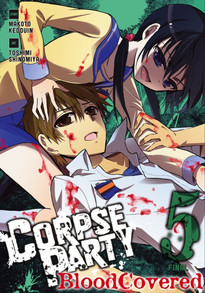Review
by Rebecca Silverman,Corpse Party: Blood Covered
GNs 4-5
| Synopsis: |  |
||
With the students reunited after Kishinuma and Shinozaki return to Tenjin Elementary, the greater task of learning what's holding Sachiko bound to the school begins. To figure that out, the group will have to first unravel what happened to Naho, the ghost of an exorcist they've interacted with, as well as who the monster in the nurse's office is. But all of these events happened so long ago – can they really save an evil spirit fifty-five years in the making? |
|||
| Review: | |||
These volumes, according to creators Toshimi Shinomiya and Makoto Kedōin, are where the manga adaptation of Corpse Party: Blood Covered really diverges from its game original. By this point the cast is most cut back down to its first game characters (with the addition of Yui, the teacher), so the major changes come in what happens rather than who is present. This largely plays out in how the gang learns about what happened fifty-five years ago to trigger the curse on Tenjin Elementary, with the death of the school nurse from an apparent fall down the stairs in the 1950s. This in itself is an interesting detail to notice, since the majority of Japanese school ghost stories that involve entire haunted buildings that I've encountered tend to rely on the schools being built over World War Two-era “research” facilities or hospitals; simply by moving the timeline forward ten years, Corpse Party manages to give itself a bit of an edge. Of course, the fact that the woman's death has nothing to do with wartime experimentation or horrors does nothing to diminish the awfulness of what precipitated her fall and the curse of Sachiko. It turns out to be a story we've read before in other forms, one of sexual predation and the need to cover up a crime, and it honestly should be more horrific than the manga is willing to make it. While there is still an atmosphere of manufactured fear, it mostly comes from the use of dark spaces in the art and the juxtaposition between Tenjin Elementary as it was in the 1950s and how it looks now to the kids trapped inside of it. Even there, however, the art can't quite pull off gut-wrenching horror as it needs to in order to truly make the all-important flashback have the required impact. This is not to say that we need to see a full-out graphic depiction of sexual assault, but rather that a little creativity could have been employed in order to play with our perceptions and make things scarier; both Tohyo Game and Higurashi: When They Cry are good examples of implication done better than we see it here. One of the most effective pieces of this two-omnibus finale is the fate of the principal, who died around the time of the later killings. Like Sisyphus, he's cursed to a repetitive action, and one that suits his crimes with its mental and physical torment. Not only does this seem fitting for the man himself, but it also provides a good scare for the Scooby Gang investigating what happened to Sachiko – seeing him repeat his actions is a time-proven method for depicting ghosts with terrible pasts, and it does make an impact in terms of motivating the group even further – and faster. The major issue here, apart from the fact that the story wastes some of its horror potential by taking too safe an artistic route, is that the denouement is too drawn out. Although the inclusion of the ghosts of Naho's mentor and his assistant are both important to the story, they aren't organically incorporated into the plot progression, especially in the case of the latter, who is introduced, used, and discarded too rapidly to make much of an emotional impact. While this may feel different if you're familiar with the sequel manga Corpse Party: Book of Shadows, at this point it simply doesn't live up to its potential. Likewise Shinozaki's tie to Sachiko isn't explained enough to feel satisfactory and instead winds up smacking of an easy out for the characters rather than an important plot revelation. Although Naomi's building survivor's guilt is well-exacerbated by later reveals, it isn't well-built enough to truly feel like it fits with the character, especially given Seiko's questionable sexual predation of her when she was alive. More of an issue, however, is the entire character of Yuka, who doesn't feel like she serves much of a point at all, and is at times almost written out of scenes entirely to the point where it's easy to forget that she's there at all. Corpse Party: Blood Covered's manga adaptation tries, it really does. At times, such as Morishige's realization in volume four and the principal's repeated actions, it does work well as a compelling horror narrative. But it takes few risks and isn't willing to be as horrific as it needs to be to truly convey the terror of the situation, either in psychological or visceral terms, and it doesn't expand on themes that could help with that, such as the idea of tongues cut out to symbolically silence the victims or friends turning against one another, both of which are recurring and potentially important. This is a series that almost makes it – and in the end, never quite does, reaching its bloodied fingers for the top only to barely leave a mark on the wall just below it. |
| Grade: | |||
|
Overall : C
Story : C
Art : C
+ Some effective horror and terror scenes, ideas of survivor's guilt decently executed |
|||
| Production Info: | ||
|
Full encyclopedia details about Release information about |
||